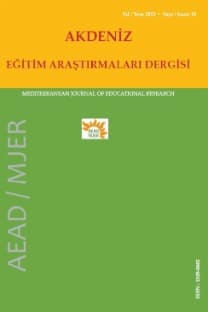Dik Temel Yazıyla Okuma-Yazma Öğrenen Öğrencilerin Okuma-Yazma Düzeylerinin Öğretmen Görüşlerine Göre Değerlendirilmesi
Evaluation of Reading-Writing Levels of Students Learning to Read and Write Through Manuscript Handwriting According to Teacher's View
___
- Akman, E., & Aşkın, İ. (2012). Ses temelli cümle yöntemine eleştirel bir bakış. Gazi Üniversitesi Gazi Eğitim Fakültesi Dergisi, 32(1), 1-18.
- Akyol, H. (2005). Türkçe ilk okuma yazma öğretimi. Ankara: Pegem Akademi.
- Arıcı, A. F. (2008). Üniversite öğrencilerinin yazılı anlatım hataları. Uludağ Üniversitesi Eğitim Fakültesi Dergisi, 21(2), 209-220.
- Aytaş, Y. (2005). Okuma eğitimi. Türk Eğitim Bilimleri Dergisi, 3(4), 461-470.
- Bay, Y. (2010). Ses temelli cümle yöntemiyle ilk okuma-yazma öğretiminin değerlendirilmesi. Kuramsal Eğitimbilim Dergisi, 3(1), 164-181.
- Bayat, S. (2015). İlkokul birinci sınıf öğrencilerinin sesli okuma becerilerinin okula başlama yaşına göre değerlendirilmesi. Karadeniz Sosyal Bilimler Dergisi, 2, 243-255.
- Bulut, P., Kuşdemir, Y., & Şahin, D. (2016). İlkokul ve ortaokulda yazı tercihi: Öğrenci ve öğretmenler hangi yazı türünü kullanıyor? Mustafa Kemal Üniversitesi Sosyal Bilimler Enstitüsü Dergisi, 13(34), 98-115.
- Coşkun, E., & Coşkun, H. (2014). İlkokul ve ortaokullardaki bitişik eğik yazı uygulamalarına ilişkin öğretmen, öğrenci ve veli görüşleri. Mustafa Kemal Üniversitesi Sosyal Bilimler Enstitüsü Dergisi, 11(26), 209-223.
- Duran, E., & Akyol, H. (2010). Bitişik eğik yazı öğretimi çalışmalarının çeşitli değişkenler açısından incelenmesi. Türk Eğitim Bilimleri Dergisi, 8 (4), 817-838.
- Duran, E. (2011). Bitişik eğik yazı harflerinin yazım şekillerine ilişkin öğretmen görüşleri. Ondokuz Mayıs Üniversitesi Eğitim Fakültesi Dergisi, 30(2), 55-69.
- Durukan, E., & Alver, M. (2008). Ses temelli cümle yönteminin öğretmen görüşlerine göre değerlendirilmesi. Uluslararası Sosyal Araştırmalar Dergisi, 1(5), 274-284.
- Ekin, K. H. (2018). Öğretmenlerin bitişik eğik yazı kullanımına dönük düşünceleri: Esenyurt ilçesi örneği. Tezsiz Yüksek Lisans Projesi, Pamukkale Üniversitesi Eğitim Bilimleri Enstitüsü, Denizli.
- Elkatmış, M. (2013). Sınıf öğretmeni adaylarını ses temelli cümle yönteminin yetişkinlere uygulanmasına ilişkin görüşlerinin analizi. Milli Eğitim Dergisi, 43 (197), 114-128.
- Göçer, A. (2010). Türkçe öğretiminde yazma eğitimi. Uluslararası Sosyal Araştırmalar Dergisi, 3(12), 178-195.
- Güneş, F. (2006). Niçin bitişik el yazı? MEB Bilim ve Aklın Aydınlığında Eğitim Dergisi, 71, 17-19.
- Güneş, F. (2013). Okuma yazma öğrenme yaşı. Journal of Theory and Praçtice in Education, 9 (4), 280- 298.
- Güneş, F. (2014). Okuma-Yazma öğretiminde cümlenin önemi. Türklük Bilimi Araştırmaları, 13, 39-48.
- Güneş, F. (2017). Bitişik eğik ve dik temel yazı savaşları. Sınırsız Eğitim ve Araştırma Dergisi, 2(3), 1-20.
- Güney, N. (2016). Öğretmenlerin yazma eğitimine yönelik düşünceleri. Uluslararası Türkçe Edebiyat Kültür Eğitim Dergisi, 5 (2), 970-985.
- Kanmaz, A. (2007). Ses temelli cümle yöntemini uygulayan yazıyla birinci sınıf öğretmenlerinin yöntem hakkındaki görüşleri ve öğrencilerin okuma yazma becerilerini değerlendirmeleri: Denizli ili örneği. Yüksek Lisans Tezi, Pamukkale Üniversitesi Sosyal Bilimler Enstitüsü, Denizli.
- Karabay, A. (2012). Eleştirel okuma-yazma eğitiminin Türkçe öğretmeni adaylarının akademik başarılarına ve eleştirel okuma-yazma düzeylerine etkisi. Doktora Tezi, Çukurova Üniversitesi Sosyal Bilimler Enstitüsü, Adana.
- Karagöz, B. (2018). Bitişik eğik yazıdan dik temel yazıya geçiş sürecinde sınıf öğretmenlerinin dik temel yazı öğretimine ilişkin görüşleri. EKEV Akademi Dergisi, 22(73), 395-413.
- Karasar, N. (2013). Bilimsel araştırma yöntemi (25. baskı). Ankara: Nobel Yayın Dağıtım. Millî Eğitim Bakanlığı (2018). Türkçe dersi öğretim programı. Ankara: MEB.
- Kırmızı, F., & Kasap, D. (2013). İlkokuma yazma öğretimi sürecinde bitişik eğik yazı ve dik temel harflerle yapılan eğitimin öğretmen görüşlerine göre karşılaştırılması. Turkish Studies, 8(8), 1167- 1186.
- Rasinski, T. (2004). Creating fluent readres. Educational Leadership, 61(6), 46-51.
- Tanju, E. H. (2010). Çocuklarda kitap okuma alışkanlığına genel bir bakış. Aile ve Toplum Eğitim Kültür ve Araştırma Dergisi, 6 (22), 30-39.
- Tuğran, M., & Akpınar, B. (2008). İlköğretim Türkçe dersi ilkokuma-yazma öğretiminde kullanılan ses temelli cümle ve bitişik-eğik yazı yöntemlerinim değerlendirilmesi. Fırat Üniversitesi Sosyal Bilimler Dergisi, 18 (1), 121-138.
- Tutal, Ö. (2013). İlk okuma-yazma öğrenmede okula başlama yaşının okuma-yazma başarısına etkisi. Yüksek Lisans Tezi, Dicle Üniversitesi Eğitim Bilimleri Enstitüsü, Diyarbakır.
- Ulusoy, M., Ertem, İ. S., & Dedeoğlu, H. (2011). Öğretmen adaylarının 1-5. sınıf öğrencilerine yönelik hazırladıkları sesli okuma kayıtlarının prozodi yeterlikleri açısından değerlendirilmesi. Gazi Eğitim Fakültesi Dergisi, 31(3), 759-774.
- Ungan, S. (2007). Yazma becerisinin geliştirilmesi ve önemi. Erciyes Üniversitesi Sosyal Bilimler Enstitüsü Dergisi, 1(23), 461-472.
- Yaşar, Ş., & Güvey Aktay, E. (2015). Okuma becerisi açısından cümle yöntemi ve ses temelli cümle yöntemi. Turkish Studies, 10 (7), 1-18.
- Yıldırım, A., & Şimşek, H. (2011). Sosyal bilimlerde nitel araştırma yöntemleri (8. bs.). Ankara: Seçkin Yayıncılık.
- Yılmaz, M. (2012). İlköğretim I. kademe öğrencilerinin kompozisyon yazma becerilerini geliştirmede planlı yazma modelinin önemi. Mustafa Kemal Üniversitesi Sosyal Bilimler Enstitüsü Dergisi, 9(19), 321-330.
- Yılmaz, F., & Cımbız, A. F. (2016). Sınıf öğretmenlerinin bitişik eğik yazı hakkındaki görüşleri. Yüzüncü Yıl Üniversitesi Eğitim Fakültesi Dergisi, 13(1), 567-592.
- ISSN: 1309-0682
- Yayın Aralığı: Yılda 4 Sayı
- Başlangıç: 2008
- Yayıncı: Tayfun Taşbilek
BEKİR BARIŞ CİHAN, Asya Kezban TAŞKIN
Okul Yöneticilerinin Öğretmenleri Güçlendirmesine İlişkin Yönetici ve Öğretmen Görüşleri
Sosyal Bilgiler Ders Kitaplarında Türk İslam Bilginleri
Exploring Possible-selves of Turkish Prospective Teachers
MUZAFFER PINAR BABANOĞLU, REYHAN AĞÇAM
Temel Eğitim Öğretmen Adayları Tarafından Benimsenen Eğitim Felsefeleri: Çanakkale İli Örneği
YASEMİN ABALI ÖZTÜRK, Zehra BİLGEN
Türkiye’deki Denizcilik Öğrencilerinin Uzakyol Deniz Stajı Probleminin İncelenmesi
İlkokul Öğrencilerinin Bilinçli Farkındalık Temelli Öz-Yeterlik Düzeylerinin İncelenmesi
Özge ÖZKAN, Hakan KARATAŞ, Atilla ERGİN
Investigation of Long-term Sea Training Problem of Maritime Students in Turkey
Öğretim İlke ve Yöntemleri Dersi İçin Bir Başarı Testi Geliştirme Süreci
